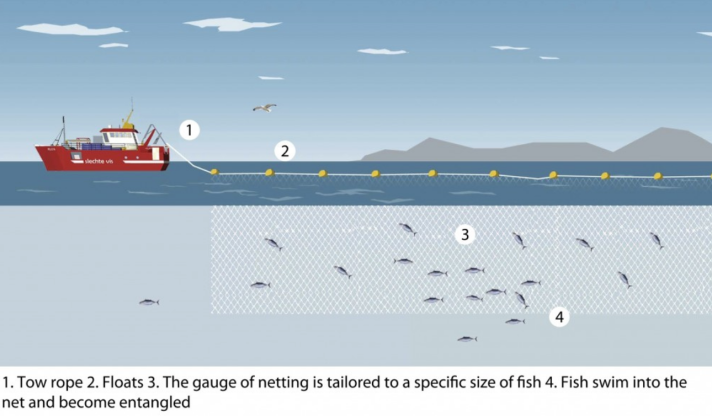Over fishing has been a problem for years, resulting in endangered and even extinct species of fish. Results from over fishing include bycatch from the large fisheries around the world. Bycatch is when fisheries use less selective fishing gear like bottom trawls, gilllnets and long lines. These forms of fishing benefits the fisheries because they can collect lots of fish, but negatively impacts the rest of the marine life that gets trapped in the nets as well.
Shrimp fisheries are some of the biggest offenders regarding this issue. For every pound of shrimp caught, six pounds of unwanted species are killed or discarded. Shrimp fisheries also collect “ trash fish” . These fish include juvenile and small fish which are sold for a profit along with the shrimp. When these fish are caught, they are unable to grow and reproduce to create new generations and keep the population stable.

“Fishing Gear with Animal Carasses” by Wikimedia Commons under CC by 2.0
With this form of fishing, a large net is used with heavy weights and is dragged across the ocean floor. It collects everything and anything in its path. Many benthic marine life is scooped up with little chance to live. These nets disturb and destruct ecosystems and corals that have been living and thriving for years. These nets also catch organisms such as shrimp, flounder, and cod. In 2007, 800,000,000 pounds of bycatch was captured breaking records for the most in one year. Over 90% of what is caught using this fishing method is bycach and unwanted organisms. Not only does this method kill unwanted organisms, it destroys the habitat and ecosystems on the ocean floor. These ecosystems are used for protection and a food source for the animals that were lucky enough not to get scooped up. Trawls are banned in some areas with high vulnerability of endangered species, but are still used and destroying the ocean floor.

“Bottom Trawling” by Wikimedia Commons under CC by 2.0
This type of net is designed so fish get their head caught but cannot get their bodies through the holes in the mesh. The fish then struggle to get free, resulting in entangling themselves even more in the net. These nets are designed for all different fish that are targeted such as salmon, cod, sea bass, sharks, and tuna. These species are very likely to be targeted for catch because they bring in such a high profit. Gillnets are especially a risk to sea turtles. Their head and fins get caught and they are forced to stay underwater, not being able to come to the surface for breath. The tight nylon can cause deadly cuts to the soft parts of their body. Dolphins, sea lions and humpback whales are also at risk when they come in contact with these nets. Some nets have a break away panels which are used to reduce bycatch, but they are not as effective as they need to be.
“
“Gillnets” by flickr under CC by 2.0
This type of net uses lines that cast up to 50 miles across the ocean. Along this line there is bait on hooks that is used to attract different fish. Unfortunately, the bait does not only attract fish they are targeting, but thousands of other marine life as well including diving birds. It is proven that using more selective methods of fishing instead of long lines reduce bycatch immensely.

“Longline Nets” by Wikimedia Commons under CC by 2.0
The Effects of Bycatch
-As a result of long lines, 15% of shark species are threatened with extinction
-200,000 logger head and 50,000 leatherback turtles are caught annually
-From 1993-200, 16,000 seabirds were killed due to Alaskan ground fish long line fisheries
-The NOAA reports baseline bycatch estimates for 481 different species
–300,000 whales, dolphins and porpoises die from these fishing methods a year
–40 tons of cold water corals are caught by bottom trawlers in the North Pacific Ocean
To this day, there are about 130 bycatch agreements and regulations set in place. Even with these rules set in place, fisheries are still using these nets and some are using them illegally in protected waters. Fishermen do not like bycatch either, because it takes more time to sort out the targeted fish, and can damage their equipment from animals like sharks. You would think that finding more selective fishing methods would be their goal.
“Hidden Disgrace“ by YouTube under CC by 2.0
So What Can We Do?
Streamer lines are used which reduce sea bird death, and they are also cost effective. Regulations have also been put in place by some fisheries and around Southern Georgia, sea bird death has declined by 99% because of the regulations. New sustainable fishing gear is being tested by the WWF in hopes to make fishing more selective. Sustainability and selective fishing need to be enforced in these large fisheries in hopes of reduction of bycatch. As consumers of fish, people can make more sustainable choices instead of the popular tuna and shrimp, which are targeted fish that have the most bycatch.
Have you looked into whether or not there are rules and regulations to using certain gear to catch fish? It seems wild to allow fisherman to just catch whatever and discard the rest. Especially since we as the public have strict rules and regulations when just leisurely fishing.
LikeLiked by 1 person
Yes there are certain rules and regulations fishermen need to follow. In certain areas these nets are banned but are used in illegal fishing.
LikeLiked by 1 person